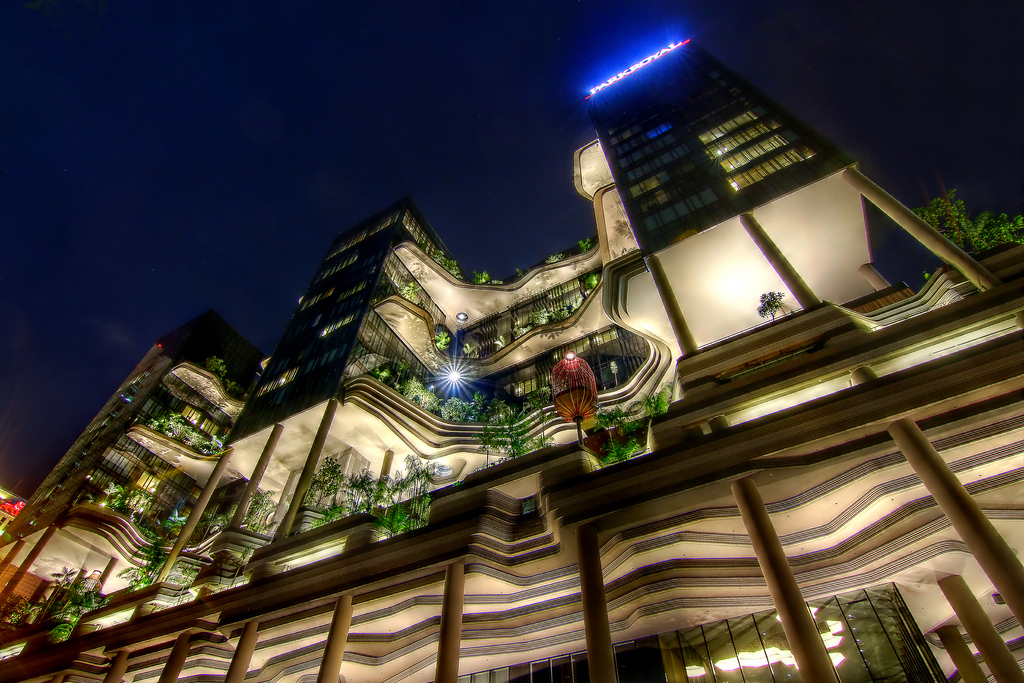Singapore's Parkroyal on Pickering not only has tiers of greenery draped in its contours, but the ample open air space for the outdoor plazas and gardens at the base of the building make it look like the hotel is floating. The design allows the building to max out on space: The 15,000 sm of plantings, water features, waterfalls, terraces and green walls come out to 215% of the site's area.
This week, the Council on Tall Buildings and Urban Habitat (CTBUH) named the Parkroyal on Pickering the Urban Habitat Award winner for 2015. The award, which was founded in 2014, recognizes tall buildings' contributions to the urban realm.
The five-star hotel and four other finalists were chosen "for their exemplary designs that are intelligently influenced by both their environmental and cultural context, and which add to the social sustainability of both their immediate and wider settings," according to a CTBUH press release.
The winners and finalists will be celebrated at an awards ceremony at the Illinois Institute of Technology in Chicago on November 12. The symposioum will have presentations from the owners and architects of each building.
The four other finalists were:
• Chatswood Transport Interchange (CTI) in Sydney, Australia
• d’Leedon in Singapore
• Jing An Kerry Centre in Shanghai, China
• Tour Carpe Diem in Paris, France
Related Stories
| May 15, 2013
Schneider Electric announces Global Xperience Efficiency Events for 2013
Schneider Electric’s Xperience Efficiency series will begin with events in the United States, China, Colombia, Brazil and Russia.
| May 15, 2013
Center for Green Schools, Architecture for Humanity release new tool for green schools
The 70-page guide demystifies the processes of identifying building improvement opportunities and finance and implementation strategies.
| May 14, 2013
Paints and coatings: The latest trends in sustainability
When it comes to durability, a 50-year building design ideally should include 50-year coatings. Many building products consume substantial amounts of energy, water, and petrochemicals during manufacture, but they can make up for it in the operations phase. The same should be expected from architectural coatings.
| May 14, 2013
Advanced turbines generate 6X more energy than conventional models
US-based wind energy company SheerWind just unveiled the INVELOX – a tunnel-based wind turbine that can produce up to 600% more power than traditional wind turbines.
| May 14, 2013
Raymond Clark joins HOK’s Chicago Practice as Management Principal
HOK announced today that Raymond Clark, AIA, LEED AP, has joined its leadership team in Chicago as senior vice president and management principal.
| May 14, 2013
Easy net-zero energy buildings [infographic]
"Be a Zero Hero" infographic educates building industry professionals on ultra energy-efficient structural insulated panel construction
| May 9, 2013
10 high-efficiency plumbing fixtures
From a "no sweat" toilet to a deep-well lavatory, here's a round up of the latest high-efficiency plumbing fixtures.
| May 9, 2013
Post-tornado Greensburg, Kan., leads world in LEED-certified buildings per capita
Six years after a tornado virtually wiped out the town, Greensburg, Kan., is the world's leading community in LEED-certified buildings per capita.
| May 8, 2013
Preventable curtain wall failures - AIA/CES course
In many cases, curtain wall failures are caused by fairly simple errors that occur during the fabrication and installation process. This presentation will highlight common errors and when they typically occur.

















